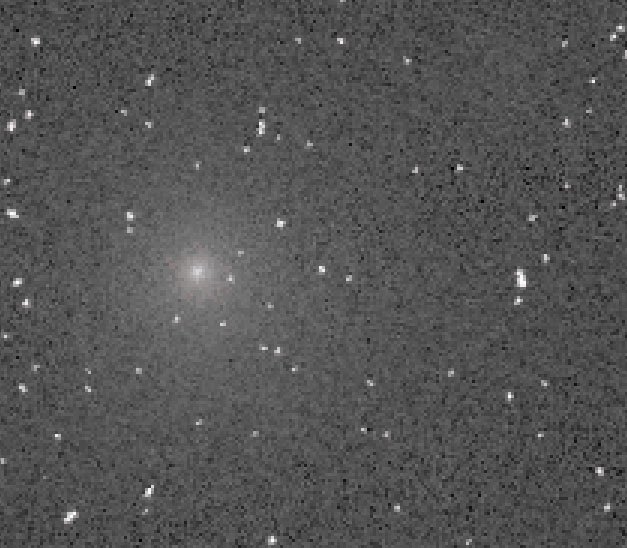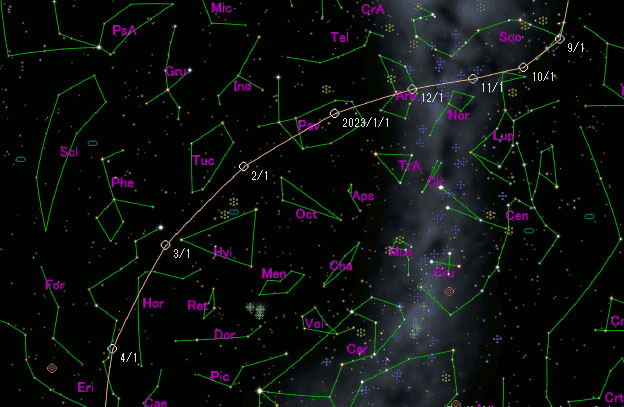

COMET OF THE WEEK
WEEK 24: JUNE 7-13
COMET PANSTARRS C/2017 K2
Perihelion: 2022 December 19.67, q = 1.797 AU
Intrinsically, this week’s “Comet of the Week” is one of the brightest ever detected – its intrinsic brightness being comparable to that of Comet Hale-Bopp C/1995 O1 – and while it certainly possesses the potential to become a bright, perhaps even conspicuous, naked-eye object around the time of its perihelion passage, its somewhat large perihelion distance, combined with the fact that it remains far from Earth and will be visible only under mediocre viewing geometry, will likely keep it from becoming “Great.” Furthermore, since it will be accessible only from the southern hemisphere for almost a full year around the time of perihelion, as far as observers in the northern hemisphere are concerned any potential it might have for becoming conspicuous is quite limited.
At the time of its discovery by the Pan-STARRS program based in Hawaii on May 21, 2017, the comet was about magnitude 19.5, and despite being located at a heliocentric distance of 16.1 AU was already clearly active. Researchers later identified images of it on exposures taken with the Canada-France-Hawaii Telescope at Mauna Kea as far back as May 12, 2013, at which time it was located 23.7 AU from the sun – the second-largest heliocentric distance at which any long-period comet has ever been detected; it was about magnitude 22.5 but was still showing activity even at that distance. Since this is far too large a distance for the sublimation of water ice, researchers have concluded that the activity was driven by sublimation of substances like carbon dioxide, carbon monoxide, and molecular oxygen and nitrogen.

 LEFT: Pre-discovery image of Comet PANSTARRS taken with the Canada-France-Hawaii Telescope at Mauna Kea on May 12, 2013, when its heliocentric distance was 23.7 AU. From the paper by Jewitt et al. (2017). RIGHT: Hubble Space Telescope image of Comet PANSTARRS taken on June 27, 2017, when its heliocentric distance was 15.9 AU. Courtesy NASA.
LEFT: Pre-discovery image of Comet PANSTARRS taken with the Canada-France-Hawaii Telescope at Mauna Kea on May 12, 2013, when its heliocentric distance was 23.7 AU. From the paper by Jewitt et al. (2017). RIGHT: Hubble Space Telescope image of Comet PANSTARRS taken on June 27, 2017, when its heliocentric distance was 15.9 AU. Courtesy NASA.
Traveling in an orbit almost perpendicular to the ecliptic (inclination 87.5 degrees), Comet PANSTARRS has brightened steadily ever since its discovery as it has approached the inner solar system, and presently is around 15th to 16th magnitude. It is currently at opposition at a heliocentric distance of 8.9 AU, and located within the “head” of the constellation Draco. It travels slowly southward over the coming months, and will be in conjunction with the sun – 59 degrees north of it – in mid-December. A year from now it is again at opposition, when its heliocentric distance will be 6.1 AU and it will be located 10 degrees south of its current location; by then it may be close to 13th magnitude and thus amenable to visual observations. One year later, i.e., in mid-June 2022, it will once again be near opposition, at a heliocentric distance of 2.9 AU and located in northern Ophiuchus; by then it should be bright enough to detect with binoculars and perhaps may even be close to naked-eye visibility.

 Images of Comet PANSTARRS I've taken with the Las Cumbres Observatory network that illustrate its development over the past two years. Left: Image taken from the LCO facility at McDonald Observatory in Texas on March 6, 2018, when the comet’s heliocentric distance was 14.4 AU. It is the small diffuse object in the center. Right: Image taken from the LCO facility at Teide Observatory in the Canary Islands on May 15, 2020, when the comet’s heliocentric distance was 9.2 AU. It is just to the lower left of center.
Images of Comet PANSTARRS I've taken with the Las Cumbres Observatory network that illustrate its development over the past two years. Left: Image taken from the LCO facility at McDonald Observatory in Texas on March 6, 2018, when the comet’s heliocentric distance was 14.4 AU. It is the small diffuse object in the center. Right: Image taken from the LCO facility at Teide Observatory in the Canary Islands on May 15, 2020, when the comet’s heliocentric distance was 9.2 AU. It is just to the lower left of center.

As is always the case with inbound long-period comets, any forecasts as to its brightness should be taken cautiously. The comet appears to be a “new” one making its first visit to the inner solar system from the Oort Cloud, and as discussed in a previous “Special Topics” presentation such objects tend to under-perform compared to what their earlier brightnesses might suggest. The fact that Comet PANSTARRS appears to be quite bright intrinsically and was active at such large heliocentric distances works in its favor, but its rather large perihelion distance, its remaining far from Earth, and its poor geometric viewing conditions around the time of perihelion work against it. The comet should certainly reach naked-eye brightness, perhaps 5th magnitude, and could become somewhat brighter than that; 3rd magnitude perhaps is reasonable, and while I would consider a peak brightness of 1st magnitude as unlikely, it is not out of the question. As I stated at the outset, though, I doubt that this will become a “Great Comet,” although I suppose one never knows. We will just have to wait and see what the comet does.
“Comet of the Week” archive
Ice and Stone 2020 home page
Earthrise Institute home page